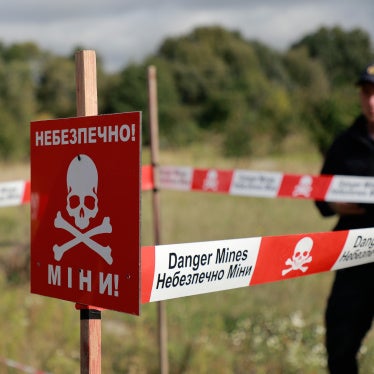Thank you for the floor.
Human Rights Watch is one of the founders of the Campaign to Stop Killer Robots and the global coordinator of the Campaign. Over the past six years, we have urged High Contracting Parties to identify options for addressing the host of dangers posed by fully autonomous weapons, and to act concretely on those options.
We remain convinced that the only viable option is a preemptive prohibition on the development, production, and use of fully autonomous weapons. A majority of the world’s nations have called for negotiations on a legally binding instrument with prohibitions and restrictions. The UN SecretaryGeneral has called these weapons “morally repugnant and politically unacceptable.”
Yet a small group of states continues to impede significant progress in the CCW. The time is rapidly approaching when options other than the CCW must be considered.
Lethal autonomous weapons systems are not the only issue of deep concern in the CCW. Human Rights Watch also places a high priority on incendiary weapons. As we note in a new paper released this week, Protocol III imposes some restrictions on the use of incendiary weapons, but fails to provide sufficient protections for civilians.
Over the past year, the Syrian-Russian military alliance has continued to use incendiary weapons in or near civilian areas in Syria. In May and June alone, incendiary weapons were used at least 27 times, mostly in Idlib governorate, but the total number is most likely higher. A May 25 incendiary weapon attack in the Khan Sheikhoun area of Idlib burned approximately 175,000 square meters of farmland.
Since the conflict in Syria began in 2012, Human Rights Watch has documented about 150 incendiary weapon attacks by the Syrian-Russian military alliance. Human Rights Watch has used open-source material, satellite imagery analysis, and interviews to identify the attacks.
Incendiary weapons can inflict severe burns, leave extensive scarring, and cause respiratory damage and psychological trauma. They also start fires that destroy civilian homes, objects, and infrastructure.
There is a clear humanitarian imperative to deal with these cruel weapons. Yet at the last annual meeting of the CCW in November 2018, Russia blocked consensus on a widely supported proposal to continue dedicated discussions on incendiary weapons in 2019.
Protocol III has two major loopholes. First, its definition of incendiary weapons excludes multipurpose weapons, such as those with white phosphorus. White phosphorus munitions may be primarily designed to provide smokescreens or illumination, but they can inflict the same horrific injuries as other incendiary weapons.
Second, Protocol III prohibits the use of air-dropped incendiary weapons in populated areas, but allows the use of ground-delivered models in certain circumstances. Because all incendiary weapons cause the same effects, this arbitrary and outdated distinction should be eliminated. A complete ban on incendiary weapons would have the greatest humanitarian benefits.
During this meeting, High Contracting Parties should take the following steps:
- set aside time in 2020 for an in-depth discussion of the implementation and adequacy of Protocol III;
- condemn any use of incendiary weapons;
- express their views on the adequacy of Protocol III, and elaborate policies and practices more generally; and
- reinstate incendiary weapons as a separate agenda item for the CCW.
For the longer term, states should work to close Protocol III’s loopholes and further stigmatize the use of incendiary weapons, with an eye to agreeing to amend the instrument at the 2021 Review Conference.
Thank you.








